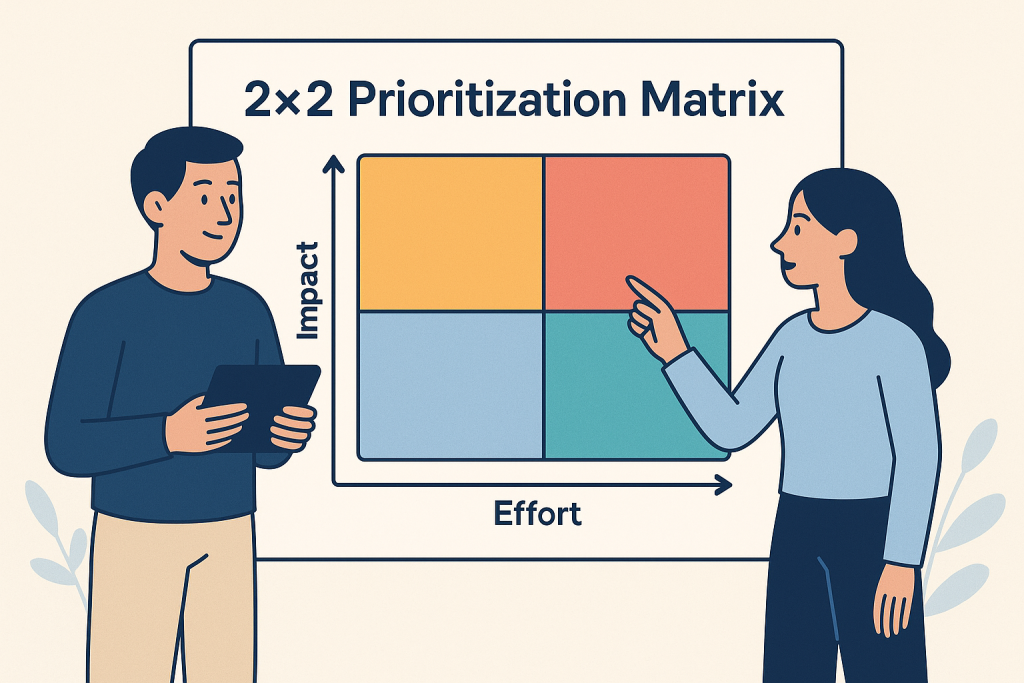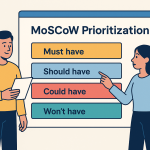What is a 2×2 Prioritization matrix?
In a world where teams juggle countless projects, features, and tasks simultaneously, the challenge isn’t finding things to work on—it’s deciding what deserves attention first. The 2×2 prioritization matrix cuts through this complexity with elegant simplicity, offering teams a visual framework that transforms overwhelming backlogs into clear action plans.
The method centers around creating a grid with four distinct quadrants, using two critical dimensions to evaluate every potential project or task. The vertical axis represents “importance”—how much value an item will deliver to your customers, business, or objectives. The horizontal axis measures “effort”—the time, resources, and complexity required to complete the work. This intersection creates four strategic zones that guide decision-making with remarkable clarity.
Key Components of the Matrix:
- High Impact, Low Effort (Quick Wins): Immediate priorities that deliver maximum value with minimal investment
- High Impact, High Effort (Major Projects): Strategic initiatives requiring significant planning and resources
- Low Impact, Low Effort (Fill-in Tasks): Minor activities to complete when capacity allows
- Low Impact, High Effort (Time Wasters): Projects to avoid or eliminate from consideration
Each quadrant tells a different story about priority and timing. High-value, low-effort items occupy the coveted “quick wins” space, while high-value, high-effort projects represent significant investments worth planning carefully. The framework doesn’t just categorize work—it reveals strategic insights about resource allocation and helps teams avoid the trap of being busy without being productive.
Why is the 2×2 Priority Matrix Lean?
The 2×2 prioritization approach aligns naturally with lean methodology principles, creating a decision-making process that maximizes value while minimizing waste. This alignment isn’t coincidental—both approaches recognize that success comes from focusing intensely on what matters most rather than trying to do everything at once.
By concentrating on high-value, low-effort opportunities first, teams can deliver meaningful results quickly and frequently. This rapid delivery cycle creates momentum and provides early feedback that can inform larger decisions. Instead of investing months in uncertain projects, teams can validate assumptions and build confidence through smaller, strategic wins that compound over time.
The matrix also serves as a powerful tool for eliminating waste—one of lean methodology’s core principles. When teams plot all potential projects visually, the low-value initiatives become obvious, making it easier to say no to work that won’t meaningfully impact customers or business outcomes. This clarity prevents teams from dispersing their energy across too many fronts and helps maintain focus on activities that truly drive progress.
Who Can Use this 4 Square Matrix?
While agile development teams popularized the 2×2 prioritization matrix for managing product backlogs and sprint planning, its applications extend far beyond software development. The framework’s versatility makes it valuable for anyone facing complex prioritization decisions, regardless of industry or role.
Product teams use this approach to identify essential features for minimum viable products, ensuring they build only what’s necessary to test market assumptions. Marketing teams apply the same logic to campaign strategies, weighing potential impact against resource requirements. Executives use similar frameworks to evaluate market opportunities, partnership possibilities, or strategic initiatives.
The beauty of the 2×2 matrix lies in its adaptability. The axes can be customized to reflect whatever trade-offs matter most in your context:
Common Business Applications:
- Revenue potential vs. implementation cost
- Customer impact vs. technical complexity
- Market size vs. competitive intensity
- Strategic value vs. resource requirements
- Risk level vs. potential return
- Brand impact vs. execution difficulty
Personal and Professional Use Cases:
- Life impact vs. time investment
- Career advancement vs. effort required
- Learning value vs. difficulty level
- Health benefits vs. lifestyle changes
- Relationship building vs. social energy
- Skill development vs. learning curve
One particularly well-known variation is the Eisenhower Matrix, developed by President Dwight Eisenhower for personal time management. This version uses importance and urgency as its axes, helping individuals distinguish between what feels urgent and what actually matters for long-term success.
An Example of a 2×2 Priority Matrix
Consider a software team transitioning their application to a subscription-based pricing model—a common scenario that involves numerous interconnected decisions and competing priorities. The team faces multiple projects, each with different value propositions and resource requirements, making prioritization both crucial and challenging.
Three key projects emerge from their planning session: building an integration with a subscription platform, designing the complete customer journey from trial to purchase, and enabling international purchases with multiple currency support. Each project seems important, but resources are limited and timing matters significantly for their business goals.
When plotted on their 2×2 matrix, the customer journey design lands squarely in the high-value, low-effort quadrant. This work requires mainly design thinking and user experience planning—activities that can happen quickly but will dramatically improve conversion rates and user satisfaction. The team recognizes this as their immediate priority, something they can complete while building momentum for larger initiatives.
The subscription platform integration falls into the high-value, high-effort category. While technically complex and time-consuming, this work is essential for the business model transition. Its placement in the “do next” quadrant reflects its importance while acknowledging that rushing into development without proper customer journey planning would be premature.
International currency support represents a lower-value addition that serves a small percentage of their user base. Despite being technically straightforward, it ranks lower in priority because the impact doesn’t justify immediate attention when higher-value opportunities exist.
This example illustrates how the matrix transforms abstract prioritization discussions into concrete, defensible decisions. Rather than debating which project feels more important, the team can point to specific criteria and explain their reasoning to stakeholders, creating alignment and reducing second-guessing.
Successful implementation of the 2×2 matrix requires thoughtful consideration of how to define and measure both axes. “Value” might seem straightforward, but it can encompass customer satisfaction, revenue impact, strategic alignment, learning opportunities, or risk mitigation—depending on your context and objectives. Similarly, “effort” extends beyond simple time estimates to include technical complexity, coordination requirements, opportunity costs, and resource availability.
The most effective teams regularly revisit and refine their matrix as new information emerges. Initial estimates often prove incorrect, and changing market conditions can shift value calculations dramatically. The framework works best when treated as a living tool rather than a one-time exercise, with regular updates reflecting new insights and evolving priorities.
Some teams enhance the basic model by adding additional dimensions or using more sophisticated scoring systems. However, the power of the 2×2 matrix lies in its simplicity—adding too much complexity can defeat the purpose of creating clarity and enabling quick decision-making.
The 2×2 prioritization matrix succeeds because it forces teams to confront fundamental questions about value and feasibility while providing a shared language for discussing trade-offs. It transforms subjective opinions into structured analysis, helping teams move beyond personal preferences toward decisions based on strategic criteria. When implemented thoughtfully, the matrix becomes more than a planning tool—it becomes a framework for building organizational discipline around focusing on what matters most. The simple act of plotting work visually reveals patterns and insights that remain hidden in traditional priority lists, enabling teams to make smarter choices about where to invest their limited time and energy.


